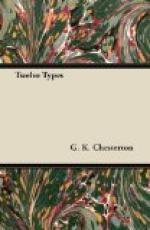WILLIAM MORRIS AND HIS SCHOOL
It is proper enough that the unveiling of the bust of William Morris should approximate to a public festival, for while there have been many men of genius in the Victorian era more despotic than he, there have been none so representative. He represents not only that rapacious hunger for beauty which has now for the first time become a serious problem in the healthy life of humanity, but he represents also that honourable instinct for finding beauty in common necessities of workmanship which gives it a stronger and more bony structure. The time has passed when William Morris was conceived to be irrelevant to be described as a designer of wall-papers. If Morris had been a hatter instead of a decorator, we should have become gradually and painfully conscious of an improvement in our hats. If he had been a tailor, we should have suddenly found our frock-coats trailing on the ground with the grandeur of mediaeval raiment. If he had been a shoemaker, we should have found, with no little consternation, our shoes gradually approximating to the antique sandal. As a hairdresser, he would have invented some massing of the hair worthy to be the crown of Venus; as an ironmonger, his nails would have had some noble pattern, fit to be the nails of the Cross. The limitations of William Morris, whatever they were, were not the limitations of common decoration. It is true that all his work, even his literary work, was in some sense decorative, had in some degree the qualities of a splendid wall-paper. His characters, his stories, his religious and political views, had, in the most emphatic sense, length and breadth without thickness. He seemed really to believe that men could enjoy a perfectly flat felicity. He made no account of the unexplored and explosive possibilities of human nature, of the unnameable terrors, and the yet more unnameable hopes. So long as a man was graceful in every circumstance, so long as he had the inspiring consciousness that the chestnut colour of his hair was relieved against the blue forest a mile behind, he would be serenely happy. So he would be, no doubt, if he were really fitted for a decorative existence; if he were a piece of exquisitely coloured cardboard.




